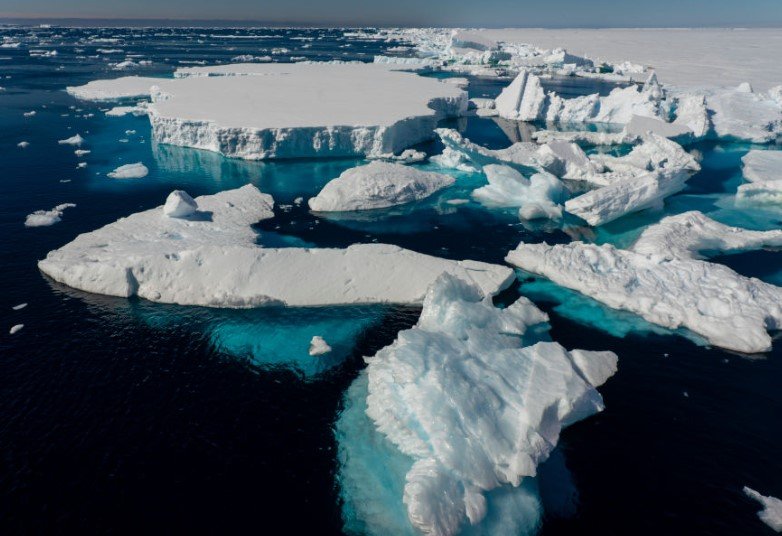Scientists have discovered a surprising twist in climate change effects around Antarctica. A fresh study shows that melting ice creates a light water layer on the Southern Ocean, locking away carbon dioxide deep below and keeping it from escaping into the air.
This finding comes from experts at a leading research institute who analyzed decades of ocean data. Published in a major journal this month, the research explains why the Southern Ocean still absorbs huge amounts of CO2 despite warming trends. But this natural shield may not hold forever, raising concerns for global warming.
Why the Southern Ocean Acts as a Key Carbon Sink
The Southern Ocean surrounds Antarctica and plays a vital role in fighting climate change. It soaks up about 40 percent of the CO2 that oceans absorb from human activities each year.
This process happens through a natural cycle where cold surface water sinks, carrying CO2 to the depths. At the same time, older water rises, but recent changes have kept much of that deep CO2 trapped.
Experts note that without this ocean’s help, atmospheric CO2 levels would rise faster, speeding up global warming. Recent data from 2025 shows the ocean absorbed over 1.5 billion tons of CO2 last year alone.
Strong winds in the region usually mix water layers, but something has changed. Researchers point to melting ice as the main factor creating a barrier.

How Melting Ice Forms a Protective Freshwater Cap
Fresh water from Antarctica’s melting glaciers and ice sheets flows into the Southern Ocean. This water is less salty and lighter than the deeper, saltier layers.
As a result, it forms a cap on the surface that stops deep water from rising easily. This stratification has grown stronger since the 1990s, based on ship measurements and satellite data.
In the last three decades, the boundary between surface and deep waters has risen by about 40 meters. This keeps carbon-rich water down, allowing the ocean to take in more CO2 from the air.
However, warming trends are making winds stronger, which could erode this cap over time. Logical reasoning suggests that if mixing increases, stored CO2 might release suddenly, like a burst from an overfilled balloon.
Scientists used computer models to test this idea. They found that without the freshwater input, the ocean’s CO2 absorption would have dropped by 20 percent already.
| Factor | Impact on CO2 Absorption | Current Trend in 2025 |
|---|---|---|
| Melting Ice | Adds fresh water, strengthens surface cap | Increasing due to record Antarctic melt |
| Wind Strength | Pushes deep water up, risks mixing layers | Rising with global warming |
| Rainfall | Boosts fresh water on surface | Higher in Southern regions |
| Ocean Circulation | Sinks CO2 to depths | Slowing by 30% since 1990s |
The Fragile Balance and Potential Risks Ahead
This protective cap seems stable now, but experts warn it is temporary. If winds keep intensifying, they could break through the layer and release trapped CO2.
Recent events, like the extreme Antarctic heatwave in 2024, melted more ice than ever, adding to the fresh water. Yet, this same melt might speed up the breakdown if it alters ocean currents too much.
One risk is a feedback loop where released CO2 warms the planet more, causing even faster ice melt. This could weaken the Southern Ocean’s role as a carbon sink by mid-century.
Another concern ties to marine life. Less mixing might limit nutrients reaching the surface, harming plankton and fish populations that depend on them.
Studies from Arctic regions show similar patterns, where ice melt affects CO2 uptake. In the Arctic, bacteria under ice are boosting algae growth, which absorbs more CO2, but Antarctica’s case is unique due to its scale.
What Recent Research Tells Us About Future Changes
The latest 2025 research builds on earlier findings from expeditions dating back to 1972. It combines data from buoys, ships, and satellites for a clear picture.
Key insights include:
- Surface salinity has dropped by 0.5 units since 2000, enhancing the cap.
- Deep water CO2 levels are 10 percent higher than surface, ready to escape if mixed.
- Models predict a possible 15 percent drop in absorption by 2040 if trends continue.
These points highlight the need for ongoing monitoring. International programs are now focusing on winter data, when mixing is strongest.
Experts reason that cutting global emissions could ease pressure on this system. Without action, the ocean might shift from sink to source, adding billions of tons of CO2 to the air.
Global Impacts and Calls for Action
Changes in the Southern Ocean affect weather worldwide. Slower circulation could alter rainfall patterns in places like Australia and South America.
It might also raise sea levels faster by changing how heat moves through oceans. Recent reports link this to stronger storms in the Pacific.
On a positive note, this discovery buys time for climate efforts. It shows nature’s resilience but stresses the urgency of reducing fossil fuel use.
Share this article with friends to spread awareness about climate change. What do you think will happen if the carbon cap fails? Leave your comments below and join the discussion.
